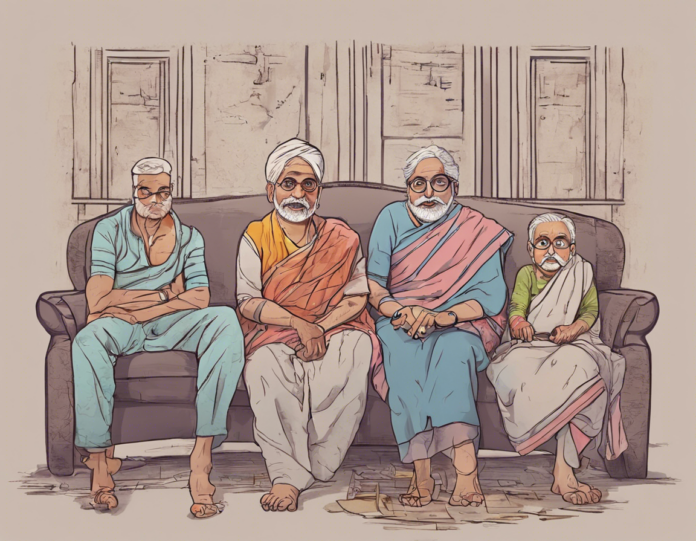India's diverse cultural landscape has always been a topic of fascination for artists and filmmakers. Recently, the Bollywood film "Badhaai Do" made waves for its bold exploration of LGBTQ+ themes within the framework of traditional Indian values. Directed by Harshavardhan Kulkarni and starring Rajkummar Rao and Bhumi Pednekar, the film delves into the complexities of sexual orientation and gender identity in a society that often struggles to reconcile modernity with age-old norms.
Cultural Norms in India: A Complex Tapestry
India has a rich tapestry of cultural norms and traditions that have shaped societal attitudes towards gender and sexuality for centuries. While the country has a long history of embracing diverse gender identities and expressions, conservative values and societal expectations often marginalize individuals who do not conform to heteronormative standards. Heteronormativity refers to the belief that heterosexuality is the norm, leading to the stigmatization of LGBTQ+ individuals and relationships.
In this context, "Badhaai Do" challenges traditional norms by portraying a same-sex couple who enter into a marriage of convenience to comply with societal expectations. The film sheds light on the struggles faced by LGBTQ+ individuals in navigating familial and societal pressures while seeking acceptance and validation for their identities.
LGBTQ+ Representation in Bollywood: A Growing Trend
Over the years, Bollywood has made significant strides in representing LGBTQ+ characters and storylines on the big screen. While early portrayals often relied on stereotypes and caricatures, contemporary films like "Badhaai Do" aim to present more nuanced and authentic representations of LGBTQ+ experiences.
In "Badhaai Do," the characters of Shardul and Suman challenge traditional gender roles and expectations by entering into a marriage of convenience that eventually blossoms into a genuine bond of love and companionship. The film's portrayal of LGBTQ+ relationships with empathy and sensitivity marks a positive shift towards more inclusive storytelling in Bollywood.
Impact of "Badhaai Do" on Cultural Discourse
"Badhaai Do" has sparked conversations about the intersection of sexuality and tradition in Indian society, prompting audiences to reflect on the complexities of identity, acceptance, and familial relationships. By depicting a same-sex couple navigating the challenges of societal acceptance, the film encourages viewers to question ingrained beliefs and prejudices that may hinder the full acceptance of LGBTQ+ individuals.
Moreover, "Badhaai Do" invites audiences to reconsider the rigid boundaries of traditional masculinity and femininity, advocating for a more fluid and inclusive understanding of gender and sexuality. The film's success at the box office and critical acclaim indicate a growing acceptance of diverse narratives in mainstream Indian cinema.
Challenges and Opportunities for LGBTQ+ Inclusivity
While films like "Badhaai Do" represent a step forward in LGBTQ+ inclusivity in Indian cinema, challenges persist in addressing systemic discrimination and stereotypes that continue to affect queer individuals in real life. Bollywood, as a powerful cultural influencer, has the opportunity to shape public perceptions and attitudes towards LGBTQ+ communities through thoughtful and authentic storytelling.
Increased representation of LGBTQ+ characters and narratives can help dispel myths and misconceptions, foster empathy and understanding, and promote social acceptance and inclusion. By amplifying diverse voices and experiences, Bollywood can contribute to a more equitable and inclusive society that affirms the dignity and rights of all individuals, regardless of their sexual orientation or gender identity.
Frequently Asked Questions (FAQs)
1. Why is LGBTQ+ representation important in Bollywood?
Representation matters because it allows LGBTQ+ individuals to see themselves reflected on screen, fostering a sense of validation and belonging. It also helps challenge stereotypes and promote understanding among audiences.
2. How has Bollywood's portrayal of LGBTQ+ characters evolved over the years?
Bollywood has moved from caricatured and stereotypical portrayals in the past to more nuanced and authentic representations in recent years, reflecting a changing cultural landscape and increasing acceptance of diverse identities.
3. What impact can films like "Badhaai Do" have on societal attitudes towards LGBTQ+ individuals?
Films like "Badhaai Do" can contribute to breaking down barriers and fostering empathy and acceptance towards LGBTQ+ individuals by humanizing their experiences and struggles.
4. How can Bollywood contribute to creating a more inclusive environment for LGBTQ+ talent?
Bollywood can provide more opportunities for LGBTQ+ actors, filmmakers, and writers to tell their own stories authentically and contribute to a more diverse and inclusive industry.
5. What are some common misconceptions about LGBTQ+ identities in India?
Misconceptions include equating LGBTQ+ identities with Western influence, viewing them as unnatural or deviant, and failing to recognize the diversity and complexity within the community.
In conclusion, "Badhaai Do" represents a significant milestone in Bollywood's journey towards LGBTQ+ inclusivity and representation. By challenging traditional norms and advocating for greater acceptance and understanding, the film paves the way for more diverse, authentic, and inclusive storytelling in Indian cinema. As audiences embrace diverse narratives and perspectives, Bollywood has the power to shape a more inclusive and equitable society that celebrates the richness and diversity of human experiences.

